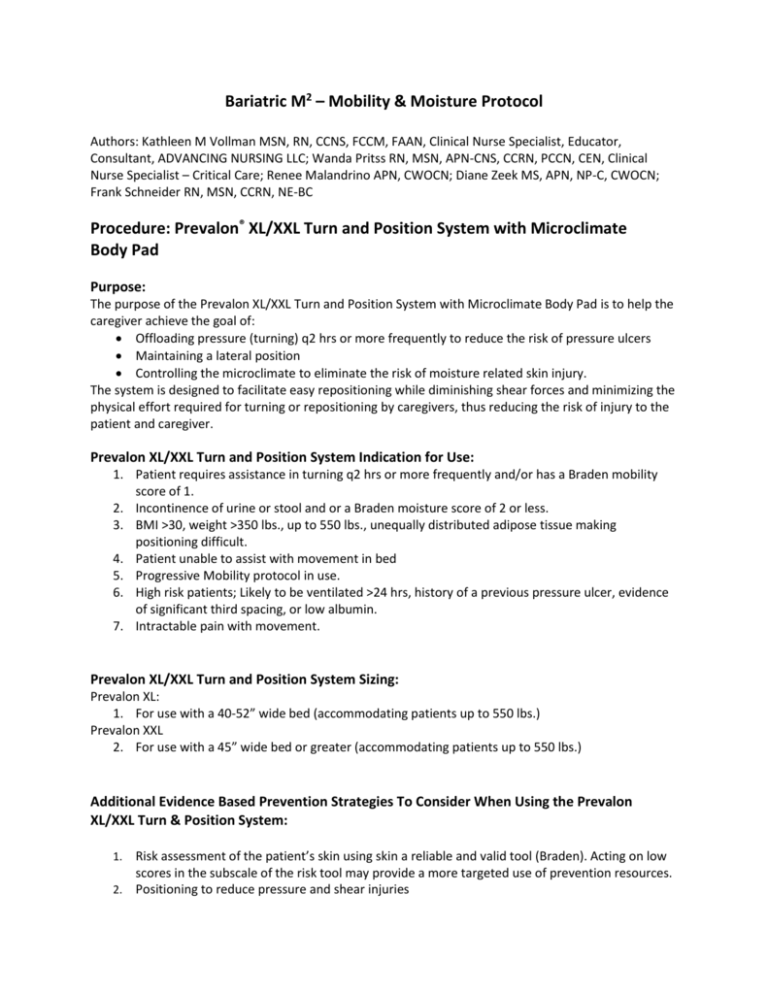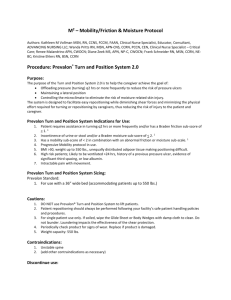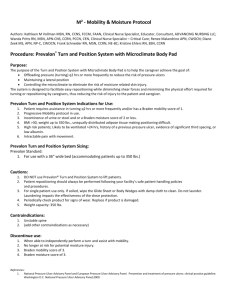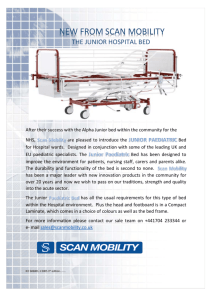Prevalon ® Turn and Position System XL/XXL
advertisement

Bariatric M2 – Mobility & Moisture Protocol Authors: Kathleen M Vollman MSN, RN, CCNS, FCCM, FAAN, Clinical Nurse Specialist, Educator, Consultant, ADVANCING NURSING LLC; Wanda Pritss RN, MSN, APN-CNS, CCRN, PCCN, CEN, Clinical Nurse Specialist – Critical Care; Renee Malandrino APN, CWOCN; Diane Zeek MS, APN, NP-C, CWOCN; Frank Schneider RN, MSN, CCRN, NE-BC Procedure: Prevalon® XL/XXL Turn and Position System with Microclimate Body Pad Purpose: The purpose of the Prevalon XL/XXL Turn and Position System with Microclimate Body Pad is to help the caregiver achieve the goal of: Offloading pressure (turning) q2 hrs or more frequently to reduce the risk of pressure ulcers Maintaining a lateral position Controlling the microclimate to eliminate the risk of moisture related skin injury. The system is designed to facilitate easy repositioning while diminishing shear forces and minimizing the physical effort required for turning or repositioning by caregivers, thus reducing the risk of injury to the patient and caregiver. Prevalon XL/XXL Turn and Position System Indication for Use: 1. Patient requires assistance in turning q2 hrs or more frequently and/or has a Braden mobility score of 1. 2. Incontinence of urine or stool and or a Braden moisture score of 2 or less. 3. BMI >30, weight >350 lbs., up to 550 lbs., unequally distributed adipose tissue making positioning difficult. 4. Patient unable to assist with movement in bed 5. Progressive Mobility protocol in use. 6. High risk patients; Likely to be ventilated >24 hrs, history of a previous pressure ulcer, evidence of significant third spacing, or low albumin. 7. Intractable pain with movement. Prevalon XL/XXL Turn and Position System Sizing: Prevalon XL: 1. For use with a 40-52” wide bed (accommodating patients up to 550 lbs.) Prevalon XXL 2. For use with a 45” wide bed or greater (accommodating patients up to 550 lbs.) Additional Evidence Based Prevention Strategies To Consider When Using the Prevalon XL/XXL Turn & Position System: Risk assessment of the patient’s skin using skin a reliable and valid tool (Braden). Acting on low scores in the subscale of the risk tool may provide a more targeted use of prevention resources. 2. Positioning to reduce pressure and shear injuries 1. a. Repositioning should be undertaken to reduce the duration and magnitude of pressure over vulnerable areas of the body. Establish a positioning schedule at a minimum of every two hours or more frequently based on the individuals condition and the support surface in use b. Repositioning, using the 30° semi fowlers or the prone position or the 30° tilted side lying positions if the individual can tolerate these positions, and the medical condition allows. c. If sitting in bed is necessary, avoid greater than 30° head of the bed elevation and/or a slouch position that places pressure and shear on the sacrum and coccyx for greater than 60 minutes. Positioning with pillows under the arms may help slouching. d. Limit the time a patient spends seated in a chair without pressure relief. (<2 hours) e. Use an active support surface, whether it is an overlay or mattress, for patients at higher risk of pressure ulcer development, where frequent manual turning is not possible. f. Greater than three layers of linen reduce the effectiveness of the pressure reduction support surface. g. For patients who are not alert & cooperative use a heel protecting device. The device should elevate the heel completely off the bed and distribute the weight of the leg along the calf without putting additional pressure on the Achilles tendon. For completely immobilized patients consider a device that incorporates prevention of external rotation of the legs to prevent plantar flexion contractures. h. Document the repositioning schedule including the frequency position and evaluation the outcome and use of heel protection aids. i. When turning acute and critically ill patients, the evidence supports waiting 5-10 minutes before assessing toleration to position change. 3. Moisture management a. Cleansing of the skin as soon as soiling occurs b. Use of a barrier on the skin with every soiling episode. Dimethicone, when in combination with zinc or petroleum, serves as an effective barrier against both urine and stool. A one step system of a barrier cloth is recommended by the IHI to improve compliance regarding skin protection related to urine and stool. c. Use of an (absorbent) incontinent pad/body pad to wick moisture away from the skin; however, still allow for airflow/breathing. d. Excessive linen use impacts the breathability of devices and or surfaces design to help maintain a healthy microclimate. Cautions: 1. DO NOT use Prevalon XL/XXL Turn and Position System to lift patients. 2. Patient repositioning should always be performed following your facility’s safe patient handling policies and procedures. 3. For single patient use only. If soiled, wipe the Glide Sheet or Body Wedges with damp cloth to clean. Do not launder. Laundering impacts the effectiveness of the shear protection. 4. Periodically check product for signs of wear. Replace if product is damaged. 5. Weight capacity: 550 lbs. If under 350 lbs., use Prevalon Standard Size Turn & Position System Contraindications: 1. Unstable spine 2. (add other contraindications as necessary) Discontinue use: 1. 2. 3. 4. When able to independently perform a turn and assist with mobility. No longer at risk for potential moisture injury. Braden mobility score of 3. Braden moisture score of 3. References: 1. National Pressure Ulcer Advisory Panel and European Pressure Ulcer Advisory Panel. Prevention 2. 3. 4. 5. 6. 7. 8. 9. 10. and treatment of pressure ulcers: clinical practice guideline. Washington D.C. National Pressure Ulcer Advisory Panel;2009. Institute for health care improvement: Prevent pressure ulcers. http://www.ihi.org/IHI/Programs/Campaign/PressureUlcers.htm. Accessed October 7th, 2007 Courtney BA, Ruppman JB, Cooper HM. Save our skin: Initiative cuts pressure ulcer incidence in half. Nursing Management. 2006;37(4):35-46. Driver DS. Perineal dermatitis in critical care patients. Critical Care Nurse 2007;27(4):42-46. Gould D, James T, Tarpey A, et al. Intervention studies to reduce the prevalence and incidence of pressure sores: a literature review. J Clin Nurs, 2000;9(2):163-177. Bergstrom N, Braden B, Kemp M, Champagne M, Rudy E. Predicting pressure ulcer risk: A multisite study of the predictive validity of the Braden scale. Nursing Research, 1998;47(5):261269 Black J, Baharestani M, Cuddigan J, et al. National Pressure Ulcer Advisory Panel’s Updated Pressure Ulcer Staging System. Derm Nurs. 2007;19(4):343–350. Gray M, Weir D. Prevention and treatment of moisture-associated skin damage (maceration) in the periwound skin. J WOCN. 2007;34(2):153–157. Vollman KM. Ventilator-associated pneumonia and pressure ulcer prevention as targets for quality improvement in the ICU. Critical Care Nursing Clinics of North America, 2006;18:453-467 Warner D, Konnerth K, (1993). “A patient teaching protocol for pressure ulcers prevention and management” Ostomy and Wound Management, 39 (2): 35-43 Procedure: Prevalon® XL/XXL Turn and Position System with Microclimate Body Pads Wash hands Ensure privacy for the patient Steps Rationale Special Considerations Instructions for Use with Empty Bed: To Begin: Make sure bed brakes are locked, bed is flat (if patient condition To provide correct positioning of the caregiver to ensure If on a low air loss bed, maximum inflation is recommended to enhance allows) and at waist level. 1. The Mattress cover provided with the Prevalon system takes the place of fitted/flat sheet. Unroll on mattress. Set Glide Sheet and Microclimate Body Pad aside until patient is available. Place the two black elastic corner straps around underside of mattress at head of bed. Mattress cover remains in place for length of patient stay. 2. Secure Straps on Mattress Cover: Attach all 4 black corner straps loosely first. Disconnect the short end of black side straps and loop around restraint target or other points of attachment. Fasten straps loosely to part of frame that moves during bed adjustment. Then tighten all straps securely and make sure Mattress Cover is completely taut on mattress. ergodynamic movement techniques to reduce the potential of caregiver injury. ease of use. A mattress cover comes with the Prevalon system. The mattress cover stays in place through corner straps and helps facilitate the interaction between the mattress cover and glide sheet for easier movement of the bariatric patient. 3. After Patient is Transferred to Bariatric Bed: Align upper edge of Glide Sheet with patient’s shoulders. Roll patient away from you onto his/her side. Tuck Glide Sheet with Body Pad under patient and unroll toward you. Raise bed rail. Use of a wide base of support is extremely important to improve balance and prevent self-injury during the turning procedure. Remove any blanket, draw sheet, diaper or incontinence pad previously in use to manage lifting/repositioning and containment of moisture. They are not necessary with the device in use. The anti-shear slide and glide technique is supported by the technology so boosting/lifting is not required to reposition in the bed. While the device is underneath the patient natural movement towards the head of the bed will occur with multiple slide and guide repositions. Once the device is no longer covering the length of the torso it needs to be re-aligned 4. Go to opposite side of bed and lower bed rail. Roll patient away from you onto his/her side. Unroll Glide Sheet with Body Pad toward you. Return patient to supine position. Center Glide Sheet with Body Pad under patient following safe patient handling policy/procedure. 5. Centering Patient on Bed: Gently slide patient using black handles on Glide Sheet to align hips hinge point on bed. Prevent patient’s heels and head from dragging across bed during repositioning. 6. Attach Anti-Shear Strap on Glide Sheet to the Mattress Cover. following the same procedure as placement. 7. Insert Body Wedges blue side up/gray side down between Mattress Cover and Glide Sheet by sliding over fabric flap on Mattress Cover. Fabric flap should be folded down over white hook and loop fastener when inserting Wedges. Off loading of the sacrum is essential to reduce the risk of pressure ulcers in patients who are unable to support themselves in a side lying position 8. Position the first Wedge under patient’s back. Position second Wedge under patient’s thigh and buttocks. Leave approximately the width of your hand (~4”/10 cm) between the positioned Body Wedges at the sacrum. 9. Grasp black handles on Glide Sheet and gently PULL (don’t lift) patient across bed horizontally toward you until patient is angled between 20-30° on Body Wedges. After placement of the Body Wedges, assess for off loading of the sacrum by placing your hand between the wedges to ensure the sacrum is free from contact with the mattress. 10. As patient is positioned, fabric flap will fold back and Wedges will lock into place on hook and loop fastener. Underside of Glide Sheet can also be adhered to hook and loop fastener on outside of Wedges. When positioned correctly, sacrum should be offloaded (free from contact). Prevent patient’s heels and head from dragging across bed during repositioning. Smooth out any wrinkles in Glide Sheet and Body Pad. Raise bed rails. 11. Adjust head of bed to desired angle. 12. Repositioning Patient: To reposition patient, gently pull up on Body Wedges to release from hook and loop fastener. Remove Wedges and follow steps 8-11 on opposite side of patient. Refer to your facility’s protocol for frequency of repositioning. Off loading of the sacrum is essential to reduce the risk of pressure ulcers in patients who are unable to support themselves in a side lying position Without attachment of the Anti-Shear Strap, the shear reduction technology of the device is reduced. Instructions for Placing Device with Patient in Bed: 1. Align upper edge of Mattress Cover with head of bed. 2. Unfold Glide Sheet and Microclimate Body Pad. Align with patient’s shoulders. Roll patient away from you onto his/her side. Tuck Mattress Cover, Glide Sheet with Body Pad under patient and unroll toward you. Raise bed rail. On opposite side of bed, roll patient away from you onto his/her side. Unroll Mattress Cover, Glide Sheet and Body pad toward you. 3. Secure Mattress Cover as outlined in step 2 under “Instructions for Use with Empty Bed.” Then refer to steps 5-11 under “After Patient is Transferred to Bed.” For instructions on repositioning patient, refer to step 12. Other Instructions: Use of a wide base of support is extremely important to improve balance and prevent self-injury during the turning procedure. Remove any blanket, draw sheet, diaper or incontinence pad previously in use to manage lifting/repositioning and containment of moisture. They are not necessary with the device in use. Changing Microclimate Body Pad: Dispose of Body Pad when soiled or saturated. Replace only with Prevalon® Microclimate Body Pads (Reorder # 7255 for XL; 7260 for XXL). Edge of Microclimate Body Pad must be aligned with edge of Glide Sheet Cleaning Instructions: If Glide Sheet or Body Wedges become soiled, wipe with damp cloth to clean. Do not launder; laundering will compromise the function of this device. The only changeable component of the system is the Microclimate Body Pad. © Advancing Nursing LLC, 2011 21592B







